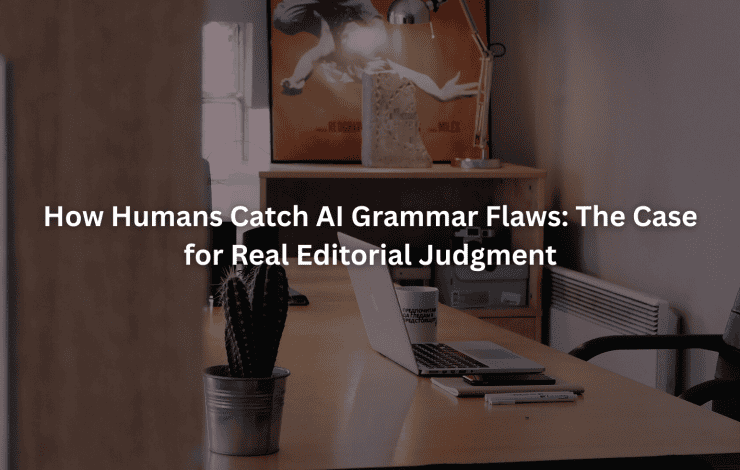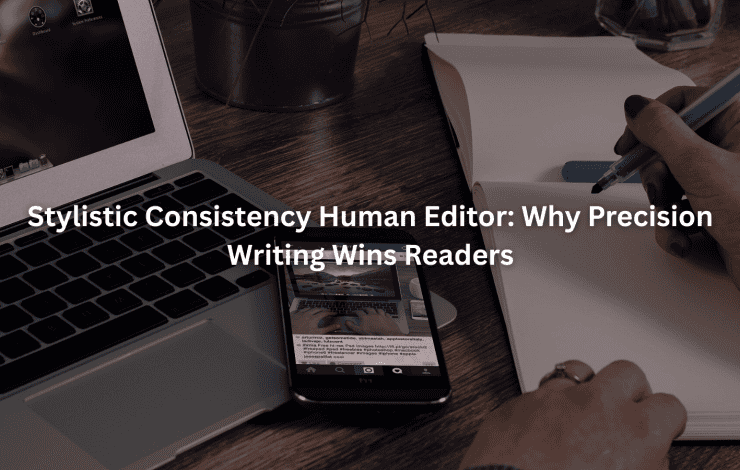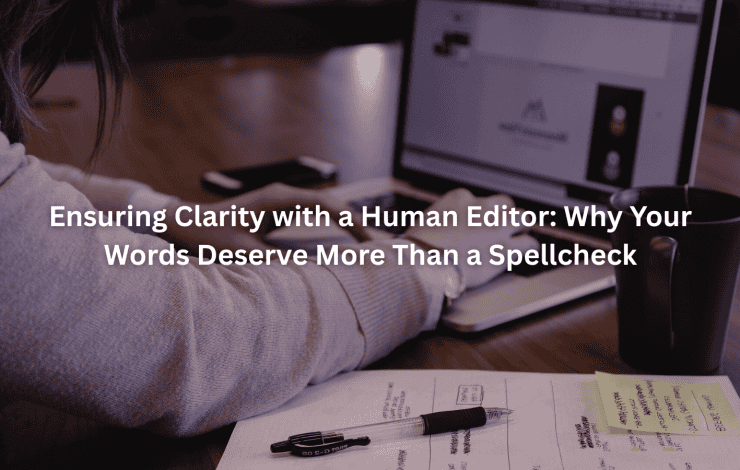Use a human editor for nuance and author intent. Rely on an AI grammar tool for speed and basic grammar corrections. Combine both for content flow, error detection, and writing clarity that stands up to scrutiny. That’s how we keep our work sharp.
Key Takeaway
- Human editors catch subtle meaning and preserve the author’s voice, handling complex context.
- AI grammar tools provide fast, reliable surface-level corrections and are always available.
- Combining both delivers the best editing accuracy, clarity, and efficiency for any document.
Human Editor vs AI Grammar Tool: Key Differences and Functions
We remember reading a draft for a friend’s memoir, and it hit me, no algorithm could have caught the double meaning in her chapter titles, or the bittersweet tone in her stories. That’s where a human editor truly shines, we look beyond the surface, piecing together meaning, intention, and style. It’s not just about grammar corrections or a punctuation check. It’s about preserving the author’s intent, keeping the narrative flow, and making sure every paragraph feels like it belongs.
On the other hand, an AI grammar tool, like the ones we use at Jet Digital Pro, scans for grammar issues, spelling review, and sentence structure in seconds. It’ll spot a missing comma or flag a run-on sentence before you can even finish reading the page. That’s efficiency. But it doesn’t always understand if a sentence is meant to be ironic, or if breaking the rules serves the story.
So, editing accuracy looks different depending on who or what’s reviewing your text. Human editors give you depth, context, and personality. AI grammar tools provide speed, consistency, and immediate feedback. And both have a place.
Understanding the Roles and Approaches
Human Editor: In-Depth and Contextual
We bring our own backgrounds, reading habits, and subject-matter expertise to every manuscript. We remember the author’s voice from chapter one and keep it steady through to the end. That’s contextual editing.
- Nuanced meaning: We catch double entendres, sarcasm, and subtle emotional shifts.
- Author intent: We ask, “What did you mean here?”, sometimes scribbling questions in the margin.
- Personalized feedback: We suggest ways to improve structure and flow, not just fix grammar issues.
A good editor’s feedback feels like a conversation, ensuring clarity with a human editor while blending technical precision and author intent.
AI Grammar Tool: Automated and Efficient
AI grammar tools, like those integrated into Jet Digital Pro’s editing system, give us the speed we need without compromising our editorial standards, and work differently.
- Rule-based grammar corrections: They check for subject-verb agreement, spelling, and punctuation.
- Pattern recognition: They spot repeated mistakes, passive voice, and awkward phrasing.
- Speed: They scan thousands of words in seconds.
These tools are algorithm-driven. They don’t tire. They don’t have off days. But they only know what they’re programmed to know. Academic researchers have noted that while AI can assist in structuring and polishing text, its current role in deep academic writing remains limited due to lack of contextual awareness and logical reasoning [ 1 ].
Core Strengths Compared

We’ve used both methods, sometimes on the same document. You notice the strengths right away.
Advantages of Human Editors
There’s a reason writers trust other humans with their work.
- Emotional intelligence: We sense tone shifts and adjust accordingly.
- Holistic feedback: We look at document structure, logic, and narrative flow.
- Subject-matter expertise: We know when a technical term is used incorrectly, or when academic editing needs extra attention.
- Style improvement: We suggest idiomatic language or creative rephrasings that an AI tool might miss.
Anecdote: Once, editing a healthcare white paper, we caught a patient anecdote that contradicted the main text. An algorithm wouldn’t have been noticed. That’s the kind of coherence review you only get from a person.
Advantages of AI Grammar Tools
But we’d be lying if we didn’t admit AI grammar tools have their place.
- High-speed processing: They pick up most grammar and spelling errors in seconds.
- Accessibility: You can run a check whenever you want, day or night.
- Cost-effective: For basic proofreading, they’re cheaper than hiring a professional.
- Consistency: They never “miss” a rule, unless the rule itself is flawed.
For blog writing or bulk content, AI tools help us move quickly, especially for surface errors and style guide compliance. At Jet Digital Pro, our workflow always starts with an AI review for these reasons.
Limitations and Challenges
Neither method is flawless and we’ve seen the same challenges come up time and again, whether we’re using a human editor or an AI grammar tool.
Human Editor Constraints
- Higher cost: Expert editing isn’t cheap.
- Longer turnaround: Deep, in-depth editing takes time, sometimes days for a longer manuscript.
- Occasional oversight: We’re human. We get tired. Sometimes, a typo sneaks through.
We once spent three days editing a technical report, only to find a minor math error on the last page. Frustrating, but that’s the risk with manual review.
AI Grammar Tool Limitations
Generic feedback: They offer rephrasing suggestions, but not detailed advice.
In fact, tools often struggle with authorial intent or tone is a key reason why humans still catch AI grammar flaws better than any algorithm.
For example, we once ran a creative writing piece through an AI tool:
- Lack of context: AI doesn’t “get” sarcasm, idioms, or regional expressions.
- Surface-level corrections: They focus on syntax correction, spelling, and grammar review. They can’t offer feedback on content flow, logic, or meaning preservation.
- No fact-checking: AI can’t tell if your statistics or arguments are accurate.
- Generic feedback: They offer rephrasing suggestions, but not detailed advice.
For example, we once ran a creative writing piece through an AI tool. It flagged every sentence fragment and suggested “fixes” that flattened the voice. That’s not helpful for narrative consistency [ 2 ].
Application Scenarios and Best Practices

We’ve learned to match the tool to the job. Not every piece of writing needs a team of editors, and not every message should be left to algorithms.
Choosing the Right Tool by Use Case
Quick Communications and Simple Edits
- Use an AI grammar tool for emails, memos, and basic blog posts.
- Fast, low-stakes, and the corrections are usually enough.
We use AI for our daily team updates. It catches typos and keeps the writing crisp, without eating up our morning.
Complex, Creative, and Academic Writing
- Bring in a human editor for long-form content, creative writing, or academic editing.
- Human editors provide substantive editing, feedback quality, and ensure logical structure.
For a client’s research paper, we always rely on deep editing from a person. The AI can’t check if a citation is placed correctly, or if the argument makes sense.
Combining Strengths: Hybrid Editing Approach
The best results come from using both.
- Initial AI-driven draft screening: Let the AI catch grammar, spelling, and surface errors.
- Final human-led editing: A person reviews for deeper issues, style, logic, and narrative flow.
At Jet Digital Pro, our human-AI editor for proofreading and grammar ensures accuracy and writing improvement for our agency clients. We start with AI for speed and consistency, then move to human proofreading for the polish.
Comparative Insights and Optimization Strategies
Are You a Digital Agency?
White Label SEO Content Services for Agencies
Scalable, customizable, and results-driven content solutions for your clients.
We’ve tested both approaches on everything from ad copy to technical manuals. Here’s what we see.
Feature-by-Feature Comparison
- Nuanced errors: Human editors spot subtle shifts in meaning and tone. AI mostly catches clear-cut grammar issues.
- Style, tone, and logic: Humans review for emotional tone, narrative flow, and style guide compliance. AI tools flag passive voice and awkward phrasing, but miss the bigger picture.
- Speed, cost, availability: AI wins for speed and price. Human editors win for depth and flexibility, but cost more and need to be scheduled.
A table helps clarify:
| Feature | Human Editor | AI Grammar Tool |
| Detects nuanced errors | Yes | Rarely |
| Considers style/tone/logic | Yes | Limited |
| Speed of corrections | No | Yes |
| Subject-matter expertise | Yes | No |
| Fact-checking | Yes | No |
| Best for complex content | Yes | No |
| Best for simple errors | No | Yes |
Enhancing Editing Outcomes
- Use AI for consistency and initial error detection.
- Rely on human editing for creative and technical documents.
- For agencies and businesses, a blended approach maximizes both quality and efficiency.
We’ve found that starting with a grammar review from AI, followed by a human’s deep editing, results in content that not only passes AI detection but also resonates with readers. Our agency partners appreciate this, especially for SEO content that needs both clarity and originality.
Practical Advice for Writers and Agencies

If you’re looking to improve your own writing, or you manage a team of writers, here’s how we do it at Jet Digital Pro and what we recommend:
- For routine content, newsletters, blog posts, internal docs, run your drafts through an AI grammar tool first. It’ll flag the obvious errors and give you a readability score.
- For high-stakes content, white papers, academic submissions, creative writing, budget for a human editor. Their feedback will be more detailed and aligned with your goals.
- If you’re an agency, develop a workflow that leverages both. Start with AI for speed and error detection, then pass to a human for final review. This keeps editing costs down and ensures content optimization.
Remember, good editing isn’t about perfection. It’s about clarity, meaning, and connecting with your audience. Whether you use a human, a machine, or both, choose the tools that fit your needs.
At Jet Digital Pro, we blend AI’s strengths with human expertise, offering white-label SEO solutions that scale for agencies. The result? Content that’s accurate, creative, and ready for search engines, without sacrificing your voice.
If you’re ready to take your editing process up a notch, try our hybrid approach. You’ll see the difference where it matters: in your writing, your results, and your readers’ response.
FAQ
How do human editors handle regional dialects or slang compared to AI grammar tools?
Human editors can usually recognize and preserve regional dialects, slang, or idiomatic expressions in writing, especially if they’ve got experience with that culture or language style. AI grammar tools often flag these phrases as errors or try to “correct” them, which can strip out the original voice. If your writing uses local language or slang, a human is far less likely to erase your intent.
Can AI grammar tools detect logical inconsistencies in long-form writing?
Need a Strategic SEO Content Partner?
Let’s craft SEO content that ranks, converts, and grows your brand.
Talk to UsAI grammar tools are built to highlight grammar, spelling, and sometimes basic phrasing issues, but they won’t catch when an argument contradicts itself two pages later, or when a story thread disappears. Human editors are much better at spotting logical gaps, plot holes, or conflicting information in essays, reports, or novels because they follow the story or argument as a whole.
Will an AI grammar tool ever suggest creative improvements, or just technical fixes?
AI grammar tools focus on technical fixes, grammar, spelling, some sentence structure, and clarity. They rarely suggest truly creative alternatives or rephrase for emotional effect. Human editors, on the other hand, can rewrite awkward lines with a sense of style, humor, or mood. If you want suggestions that add personality or spark, only a human can do that well.
Is it possible to maintain a consistent narrative voice using only an AI grammar tool?
Maintaining a consistent narrative voice is hard for an AI grammar tool. These tools usually treat every sentence as separate and don’t connect style choices across a whole document. Human editors keep an eye on voice and tone throughout, making sure your writing sounds like you from beginning to end. That’s a challenge no algorithm has fully solved yet.
How do human editors and AI grammar tools handle highly technical or academic language?
Human editors with the right background can follow technical jargon, field-specific terms, and citation rules much more accurately than AI grammar tools. AI may flag specialized language as mistakes or misunderstand the context. In academic or technical writing, a human editor not only checks for errors but also ensures the vocabulary and structure fit the field’s standards.
Conclusion
We’ve learned firsthand that the best editing comes from blending human intuition with AI’s speed. Human editors protect your voice and intent, while AI tools catch quick errors. At Jet Digital Pro, we fuse both into content that’s sharp, accurate, and resilient. It’s how we help agencies scale SEO with confidence, without sacrificing quality. Whether it’s blog writing or full content systems, trust the hybrid method that works.
Let’s elevate your content, connect with us today.
References
- https://www.researchgate.net/post/The_Role_of_Artificial_Intelligence_in_Writing_Research_Papers
- https://learn.g2.com/was-this-written-by-ai
Related Articles
- https://jetdigitalpro.com/human-ai-editor-for-proofreading-grammar/
- https://jetdigitalpro.com/ensuring-clarity-with-a-human-editor/
- https://jetdigitalpro.com/how-humans-catch-ai-grammar-flaws/
P.S – Whenever you’re ready,
we’re here to help elevate your SEO content.
Partner with us for strategic, scalable content that drives real organic growth.
Contact Us Now




